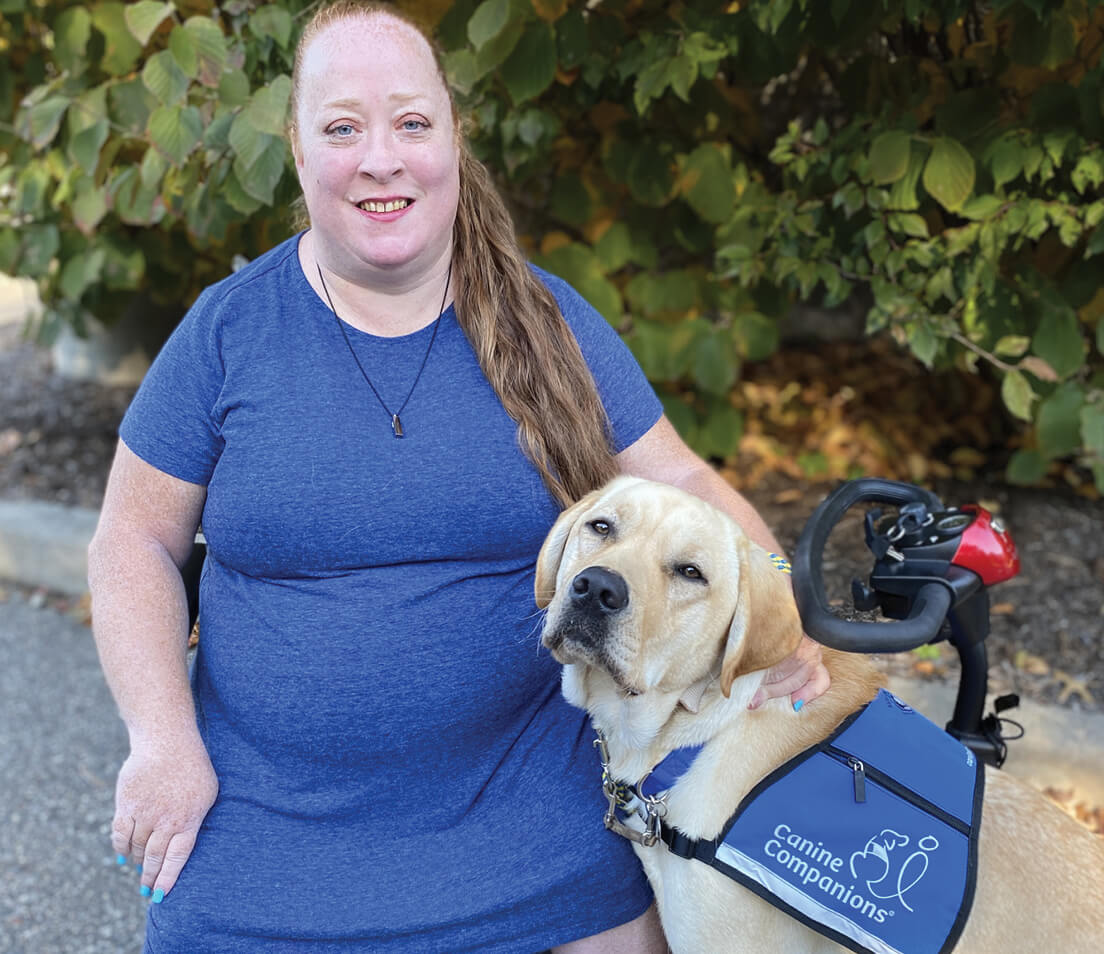Your Life
WANTED: DOGS WITH SKILLS
A new generation of service animals can help with daily tasks and even monitor medical conditions

A dog in training at Canine Companions in Medford, New York
What makes Malfoy a special dog isn’t that he can obediently sit, stay or raise a paw on command. That sort of “good boy” behavior is common for a 4-year-old Labrador retriever. But Malfoy can also carry shopping bags, hold open doors, fetch a drink from the fridge and even handle a credit card at a store’s cash register.
Malfoy does all this to help Annmarie Snow-Matera, 51, of New York City, who has a mobility disability and uses a scooter to get around. She describes her service dog with a word: “life-changing.”
If you think you’re seeing more service dogs like Malfoy in public these days, you’re not wrong. The American Kennel Club estimates there are tens of thousands nationwide, and that number has been increasing as dogs are trained to cater to a growing range of human needs.
“We often think of them as being guide dogs or hearing-assistance dogs, but we’ve come to realize that they can do so much more for individuals with a wide range of disabilities,” says Sheila Goffe, a vice president of the American Kennel Club. Some dogs have been trained to sniff out—literally—an impending medical issue in their handler, such as low blood sugar or an oncoming seizure. Other dogs can help people with post-traumatic stress disorder or traumatic brain injury, including by interrupting nightmares or reminding them when it’s time to take medication.

Annmarie with Malfoy
A NEW BREED
Service dogs today go beyond the traditional German shepherds, Labradors and golden retrievers and encompass many breeds, shapes and sizes. Although larger dogs remain best suited to physical tasks such as opening doors and adjusting light switches, dogs of any size can serve in cases when psychiatric assistance or medical alerts for epilepsy or diabetes are needed, says Kerri Rodriguez, assistant professor in the College of Veterinary Medicine at the University of Arizona. “A Chihuahua can be just as good of a service dog as a golden retriever, depending on the tasks they are trained to do,” she says.
That isn’t to say that just any dog is fit for service. Goffe says the dog must have the ability to maintain a calm temperament around other people, hone new skills and perform reliably in different environments.
WHERE DO SERVICE DOGS COME FROM?
No government agency regulates the use of service dogs. Assistance Dogs International (ADI), a coalition of service dog organizations around the world, provides some structure, listing the agencies that have completed its accreditation process.
More organizations and nonprofits have gotten into service-dog breeding, training and placement, but they can’t keep up with demand and often carry waiting lists of a year or more. The cost of getting a trained service dog typically ranges from $10,000 to $30,000, according to Bankrate, although nonprofit organizations raise money to make them affordable or even free for those in need. Private health insurance typically doesn’t pay for service animals. Nor does Medicare. To avoid the wait and expense, some people opt to train their dogs privately, though there is no guarantee that a pet will make a good service animal, says Chris Diefenthaler, ADI executive director.
DEALING WITH CONTROVERSY
The lack of unified standards has left the industry vulnerable to exploitation and deception. Anyone can buy a “service animal” vest for their pet for access to places where animals otherwise aren’t allowed, and some people even buy fake certificates online.
Then there’s the recent rise of emotional support animals, which solely provide comfort and undergo no training. A previous provision in the federal Air Carrier Access Act recognized emotional support animals as service animals. That meant “a lot of people would try to bring a pet on an airline and claim it as an emotional support animal,” Goffe says. “It was easy to claim because there was no proof required.”
In response, policymakers have cracked down on service-dog fraud. As of 2022, it was illegal in 33 states to misrepresent service animals.
One issue is that abuse of the system breeds distrust, which can make public spaces less accommodating. “The sad thing,” Goffe says, “is that very often it’s dog lovers simply wanting to bring their dog someplace with them, who didn’t realize that service-dog fraud is not a victimless crime, but something that undermines the needs of the people who rely on these dogs in their day-to-day lives.”
Julie Goldenberg is an associate editor of AARP publications.
HOW A SERVICE DOG CAN HELP
▶︎ More confidence navigating the world. “I used to always have to make sure I had somebody with me,” Snow-Matera says. “When you get one of these dogs, you get a new form of independence.”
▶︎ Caregiving help: According to research by the College of Veterinary Medicine at the University of Arizona, service dogs can reduce the caregiving workload and lead to better psycho-social health.
▶︎ A lifeline: “They quite literally save lives,” says Molly Neher, director of operations and programs for Atlas Assistance Dogs. Her dog has alerted her before the onset of seizures, allowing her to move someplace safe to avoid falls and concussions.
HOW TO GET ONE
▶︎ Though there is no official accrediting body for the industry, search online for a local organization that has been vetted by Assistance Dogs International.
▶︎ Make sure a service dog is right for you. They tend to attract attention, even though instructions on their vests advise people not to pet the dogs. For people with conditions such as extreme anxiety, the added public spotlight may be unwanted, Neher says.